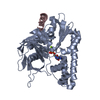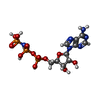+Search query
-Structure paper
| Title | A bipolar spindle of antiparallel ParM filaments drives bacterial plasmid segregation. |
|---|---|
| Journal, issue, pages | Science, Vol. 338, Issue 6112, Page 1334-1337, Year 2012 |
| Publish date | Dec 7, 2012 |
 Authors Authors | P Gayathri / T Fujii / J Møller-Jensen / F van den Ent / K Namba / J Löwe /  |
| PubMed Abstract | To ensure their stable inheritance by daughter cells during cell division, bacterial low-copy-number plasmids make simple DNA segregating machines that use an elongating protein filament between ...To ensure their stable inheritance by daughter cells during cell division, bacterial low-copy-number plasmids make simple DNA segregating machines that use an elongating protein filament between sister plasmids. In the ParMRC system of the Escherichia coli R1 plasmid, ParM, an actinlike protein, forms the spindle between ParRC complexes on sister plasmids. By using a combination of structural work and total internal reflection fluorescence microscopy, we show that ParRC bound and could accelerate growth at only one end of polar ParM filaments, mechanistically resembling eukaryotic formins. The architecture of ParM filaments enabled two ParRC-bound filaments to associate in an antiparallel orientation, forming a bipolar spindle. The spindle elongated as a bundle of at least two antiparallel filaments, thereby pushing two plasmid clusters toward the poles. |
 External links External links |  Science / Science /  PubMed:23112295 / PubMed:23112295 /  PubMed Central PubMed Central |
| Methods | EM (helical sym.) / X-ray diffraction / EM (single particle) |
| Resolution | 2 - 7.2 Å |
| Structure data | EMDB-1980: CryoEM map of ParM filament at 7.2 Angstrom resolution  PDB-4a61:  PDB-4a62: |
| Chemicals |  ChemComp-ANP:  ChemComp-MG:  ChemComp-HOH: |
| Source |
|
 Keywords Keywords | TRANSPORT PROTEIN / PLASMID SEGREGATION / ACTIN-FOLD |
 Movie
Movie Controller
Controller Structure viewers
Structure viewers About Yorodumi Papers
About Yorodumi Papers






